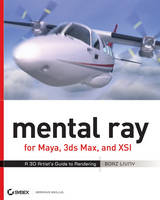
Mental Ray for Maya, 3ds Max, and XSI
John Wiley & Sons Ltd (Verlag)
978-0-470-00854-6 (ISBN)
- Titel ist leider vergriffen;
keine Neuauflage - Artikel merken
Turn 3D models into film-worthy digital animations by mastering mental ray rendering once and for all. This must-have guide is the only book on the market to focus exclusively on mental ray in Maya, 3ds Max, and XSI, and it's packed with techniques and insights you can't get anywhere else. Best of all, the book's advanced rendering concepts apply to other rendering software as well, including V-Ray, Brazil, Maxwell and RenderMan. Discover advanced lighting, camera, and workflow techniques that usually take professionals years to figure out.
Boaz Livny teaches mental ray and advanced Maya courses at New York's prestigious Center for Advanced Digital Applications and heads the Advanced Maya training at the New York Film Academy. He is also owner of Vision Animation Studios, providing film, TV, and media services for clients such as Nicktoons, AOL, The Wilderness, Cinema Factory, and more.
Introduction.Chapter 1: Introduction to mental ray.What Is mental ray?Why Use mental ray?The Structure of mental ray.mental ray Integration.Command-Line Rendering and the Stand-Alone Renderer.mental ray Shaders and Shader Libraries.Indirect Illumination.Chapter 2: Rendering Algorithms.Introduction to Synthetic Lighting.Rendering under the Hood.mental ray Rendering Algorithms.Scanline Rendering in Depth.Raytrace Rendering in Depth.Hardware Rendering.Chapter 3: mental ray Output.mental ray Data Types.The Frame Buffer.Frame Buffer Options.mental ray Cameras.Output Statements.Chapter 4: Camera Fundamentals.Camera Basics and Aspect Ratios.Camera Lenses.Host Application Settings.Chapter 5: Quality Control.Sampling and Filtering in Host Applications.Raytrace Acceleration.Diagnostic and BSP Fine-Tuning.Chapter 6: Lights and Soft Shadows.mental ray Lights.Area Lights.Host Application Settings.Light Profiles.Chapter 7: Shadow Algorithms.Shadow Algorithms.Raytrace Shadows.Depth-Based Shadows.Stand-Alone and Host Settings.Chapter 8: Motion Blur.mental ray Motion Blur.Motion-Blur Options.Motion-Blur Render Algorithms.Host Settings.Chapter 9: The Fundamentals of Light and Shading Models.The Fundamentals of Light.Light Transport and Shading Models.mental ray Shaders.Chapter 10: mental ray Shaders and Shader Trees.Installing Custom Shaders.DGS and Dielectric Shading Models.Glossy Reflection and Refraction Shaders.Brushed Metals with the Glossy and Anisotropic Shaders.The Architectural (mia) Material.Chapter 11: mental ray Textures and Projections.Texture Space and Projections.mental ray Bump Mapping.mental ray Projection and Remapping Shaders.Host Application Settings.Memory Mapping, Pyramid Images, and Image Filtering.Chapter 12: Indirect Illumination.mental ray Indirect Illumination.Photon Shaders and Photon-Casting Lights.Indirect Illumination Options and Fine-Tuning.Participating Media (PM) Effects.Chapter 13: Final Gather and Ambient Occlusion.Final Gather Fundamentals.Final Gather Options and Techniques.Advanced Final Gather Techniques.Ambient Occlusion.Chapter 14: Subsurface Scattering.Advanced Shading Models.Nonphysical Subsurface Scattering.An Advanced Shader Tree.Physical Subsurface Scattering.Appendix: About the Companion CD.Index.
| Erscheint lt. Verlag | 14.12.2007 |
|---|---|
| Verlagsort | Chichester |
| Sprache | englisch |
| Maße | 190 x 233 mm |
| Gewicht | 1534 g |
| Einbandart | Paperback |
| Themenwelt | Informatik ► Office Programme ► Outlook |
| ISBN-10 | 0-470-00854-7 / 0470008547 |
| ISBN-13 | 978-0-470-00854-6 / 9780470008546 |
| Zustand | Neuware |
| Informationen gemäß Produktsicherheitsverordnung (GPSR) | |
| Haben Sie eine Frage zum Produkt? |
aus dem Bereich


